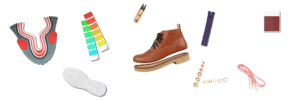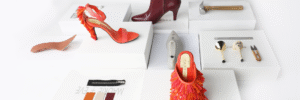Shoe lasting is a concept that often appears in the early stages of shoe design and prototyping. For many who are not familiar with shoemaking, it is easy to confuse the idea of a shoe last with other parts of the process. In reality, the shoe last is one of the most critical elements in creating footwear, serving as the foundation that determines a shoe’s shape, fit, and comfort. Without understanding this step, it’s difficult to fully appreciate how quality shoes are made. In this guide, I’d like to take some time to introduce what a shoe last is, explain its role in design, and help you gain a clearer view of this essential shoemaking concept.
Introduction: Understanding the Shoe Last
In shoemaking, one of the most essential yet often overlooked concepts is the shoe last. Typically made of wood, plastic, or metal, a shoe last is a three-dimensional mold shaped like a human foot. In simple terms, it is the “skeleton” or “framework” of a shoe, defining its form, proportions, and comfort.
To understand its importance, think of a shoe last as the foundation of a building. No matter how beautiful the blueprint may be, a structure cannot stand without a solid base. In the same way, no matter how luxurious the leather or how intricate the design, a shoe without the right last will lose its shape, feel uncomfortable, and fail to perform.
A shoe last also acts as the sculptor of a shoe’s soul. It decides whether the toe will be sharp or rounded, whether the silhouette will be sleek or full-bodied, and how much space will be allowed across the instep. For example, the difference between a sophisticated pointed stiletto and a supportive running shoe lies largely in the last. The former emphasizes elegance and line, while the latter focuses on stability and cushioning.
The reason shoe lasts are often called the foundation of shoemaking is because they guide the entire process. From the designer’s first sketches to sample development and mass production, the last ensures consistency and precision. Whether a shoe becomes an uncomfortable pair left in the closet or a timeless icon often depends on the accuracy of its last.
In short, understanding the shoe last is not just about knowing a tool of the trade—it is the first step to appreciating the craft and artistry behind every well-made shoe.

The History and Evolution of Shoe Lasts
After understanding the basic concept of a shoe last, it’s worth looking back at its history and how it has evolved over time. The earliest shoe lasts date back centuries, when craftsmen primarily carved them from wood. Wooden lasts were durable, reusable, and relatively easy to modify by hand to match a customer’s foot shape. In the era of traditional shoemaking, wooden lasts were considered the most essential tools in any workshop.
With the rise of industrialization, footwear production began to demand greater efficiency and standardization. While wooden lasts remained reliable, they were heavy and difficult to adapt for large-scale manufacturing. This led to the introduction of plastic and metal lasts. Plastic lasts offered lighter weight and lower costs, making them ideal for mass production. Metal lasts, on the other hand, provided superior strength and could withstand intensive use over long periods. Together, these innovations allowed shoemakers to maintain consistency in shape while dramatically increasing production capacity.
In recent years, the spread of 3D printing technology has brought a new revolution to the industry. Designers can now scan a customer’s feet with precision and use 3D printers to create customized lasts in a fraction of the time. This advancement has shortened development cycles and opened new possibilities for bespoke shoes, orthopedic footwear, and limited-edition luxury models tailored to individual needs.
In many ways, the evolution of the shoe last reflects the broader story of shoemaking itself: from handcrafted wood to modern plastics and metals, and now to intelligent digital solutions. Each stage of innovation has pushed the footwear industry forward, ensuring that shoes continue to balance tradition, comfort, and cutting-edge design.
Types of Shoe Lasts
Shoe lasts vary depending on gender, shoe style, and whether they are custom-made or standard. For men’s and women’s footwear, the proportions differ significantly: men’s lasts are generally wider and more robust, designed to provide stability and support, while women’s lasts are slimmer, with narrower foreparts, to match feminine foot shapes and aesthetic needs.
Different shoe categories also rely on specific lasts. Boot lasts allow extra instep height and calf fitting; sneaker lasts emphasize comfort and shock absorption space; heel lasts are narrower at the forefoot and arch to support posture and create an elegant curve; loafer lasts take a balanced approach, focusing on easy slip-on wear and daily comfort.
From the production perspective, there are standard lasts and custom-made lasts. Standard lasts are widely used in mass production and fit the majority of customers, though they cannot perfectly match individual foot variations. Custom-made lasts, however, are crafted through foot measurements or 3D scans, offering superior comfort and precision fit. These are more expensive and typically found in high-end bespoke footwear.\
Common Shoe Last Differences
| Type | Key Features | Best For |
|---|---|---|
| Men’s Last | Wide, solid, supportive | Stability, durability |
| Women’s Last | Slim, narrow forepart | Style, elegance |
| Boot Last | High instep space, calf fit | Warmth, structure |
| Sneaker Last | Extra cushioning room | Comfort, performance |
| Heel Last | Narrow forefoot, tight arch | Curves, upright posture |
| Loafer Last | Medium width, slip-on design | Casual, commuting |
| Standard Last | Mass-produced, general fit | Mainstream market |
| Custom Last | Based on personal foot shape | Premium comfort, bespoke fit |
The Role of Shoe Lasts in Shoe Design
In shoemaking, the shoe last is not just a mold—it is the foundation that determines a shoe’s comfort, fit, and overall look. Every detail of shape and proportion, from length and width to arch height, begins with the last. Without it, even the finest leather or most creative design cannot translate into a wearable shoe.
First, the last defines the basic structure. The length, width, instep height, and curvature of a shoe are all controlled by the last. This explains why shoes from different brands can feel so different on your feet, even if they appear similar at first glance.
Second, the last strongly influences the toe shape, heel height, and arch support. Consider the difference between basketball shoes and high heels. Basketball shoes are built on a last that allows for a wider forefoot, strong arch support, and extra ankle coverage, all designed to support explosive movement, quick pivots, and jumps. In contrast, high heels are made on a very different last—typically with a narrow toe box, elevated heel, and carefully calculated curvature. The high heel last emphasizes sleek, elegant lines, while still ensuring balance and wearability despite the minimal contact points with the ground.
Finally, lasts shape the aesthetic identity of shoes. A slim, elongated last produces a refined and elegant silhouette, while a chunkier last creates a bold, contemporary look. Many luxury brands design their own signature lasts, making their shoes instantly recognizable through shape alone.
In this sense, the shoe last is like the canvas of a painting. It provides the foundation on which the designer’s vision comes to life, balancing artistry with practicality. Whether it’s the athletic power of basketball shoes or the sophisticated glamour of high heels, the last determines how style and function come together in every pair.

The Lasting Process in Shoemaking
In the shoemaking process, lasting is one of the most critical stages. It ensures that the upper fits perfectly over the last and directly determines the shoe’s comfort, appearance, and durability.
The process begins by attaching the upper to the last. Once the upper has been cut and stitched, it is carefully pulled over the last. Craftsmen start from the toe, heel, and sides, gradually stretching the material to make sure it covers the last evenly. Temporary tacks, nails, or clamps are used to secure the upper in place, giving the shoe its initial structure.
Next comes the step of stretching, shaping, and securing the material. Since most uppers, particularly leather, are flexible, they must be pulled tightly to remove wrinkles and adjusted to match the curves of the last. For leather shoes, moisture or heat may be applied during this stage to soften the material, making it easier to mold into the precise shape of the last. This ensures that the finished shoe has smooth lines and a well-defined silhouette.
There are two main approaches to lasting: hand-lasting and machine-lasting. Hand-lasting is typically used for high-end or bespoke shoes. Skilled artisans rely on their experience and craftsmanship to refine every detail, adjusting tension and placement to achieve the perfect fit. Machine-lasting, on the other hand, is common in large-scale production. Automated equipment can perform the process quickly and consistently, which improves efficiency, though it offers less flexibility and individuality.
In essence, the lasting process is the step where a flat piece of material transforms into a three-dimensional shoe. Whether performed by hand or by machine, proper lasting ensures that a shoe is not only beautiful but also comfortable, laying the foundation for its overall quality.
Why Shoe Lasts Matter for Quality and Durability
In shoemaking, the last is not only the foundation of design but also the key factor that determines quality and durability. A well-designed last allows the shoe to fit the foot naturally, reducing friction and pressure points. This results in greater comfort during wear and also extends the shoe’s lifespan, since both the upper and the sole are less likely to suffer from uneven stress or premature damage.
For luxury footwear, the importance of the last cannot be overstated. Many high-end brands invest significant time and resources into developing unique lasts to ensure that their shoes deliver not only an elegant silhouette but also exceptional comfort. When customers purchase a pair of luxury shoes, they are investing in more than just footwear—they are experiencing a fusion of design, beauty, and meticulous craftsmanship.
In the world of bespoke footwear, the shoe last becomes even more central. Shoemakers craft lasts based on the exact measurements of the client’s foot, guaranteeing that every detail is tailored to individual needs. This bespoke process ensures not only superior comfort but also proper support for long-term foot health. Moreover, many artisans now offer special foot size solutions, creating custom lasts for those with wide feet, flat feet, or high arches. These adaptations allow shoes to be both stylish and anatomically supportive, addressing practical concerns while maintaining aesthetic excellence.
Ultimately, whether for everyday wear, luxury collections, or bespoke creations, the design and quality of the shoe last remain the critical benchmark for judging the value, comfort, and durability of any pair of shoes.
Innovations and Customization in Shoe Lasting
With the rise of technology and evolving consumer expectations, shoe lasts have entered a new era of innovation. Once primarily shaped by artisans through manual carving, today’s lasts are increasingly defined by digital tools and sustainable practices.
First, 3D scanning and digital lasts are becoming more widespread. Using high-precision scanning devices, shoemakers can capture a customer’s foot in exact detail and then generate a personalized last through digital modeling. This process not only shortens development time but also improves accuracy and fit, making custom footwear more scientific and efficient.
Second, personalized lasts play a crucial role in orthopedic and bespoke footwear. For customers with flat feet, high arches, or asymmetrical foot shapes, shoemakers can create unique lasts tailored to their needs. These specialized lasts provide better support, enhanced comfort, and long-term benefits for foot health. In the luxury market, this level of customization adds exclusivity and reinforces the value of bespoke craftsmanship.
Finally, sustainability in last production is becoming increasingly important. Many factories are now experimenting with recyclable plastics or responsibly sourced wood to produce shoe lasts. Others are focusing on reducing waste and extending the lifespan of lasts, thereby lowering the environmental footprint. These eco-conscious innovations align closely with modern consumer values and give luxury brands an opportunity to demonstrate responsibility and forward thinking.
In short, the innovations in shoe lasting—digital technology, personalization, and sustainability—are transforming footwear into a field where comfort, function, and responsibility meet




